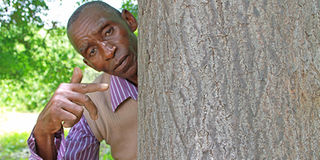Mukau will put cash in your pocket and food on the table

Jonathan Kituku who grows the Melia volkensii (mukau) in Makueni poses next to one of the 17,000 trees that he has grown. Its wood is easily worked and shaped, making it suitable for making acoustic drums, containers and mortars and is decay-resistant. PHOTO | FILE | NATION MEDIA GROUP
What you need to know:
- Apart from its quality timber, mukau’s other benefits include offering medicine, fodder, fuel wood, bee forage and manure.
- It is used for mulching and intercropping and it controls soil erosion.
- Mukau’s leaves are used on the skin of goats to control ticks and fleas.
- Kefri has also attempted to raise mukau through stem cuttings and tissue culture with limited success.
Melia volkensii is indigenous to Africa’s arid and semi-arid lands. Common in Ethiopia, Kenya, Somalia and Tanzania, it is sometimes referred to as the African mahogany because of its hard and expensive wood.
In Kenya, it grows in Kitui, Machakos, Embu, Taita-Taveta, Samburu, Isiolo, Makueni, Marsabit and Mandera counties.
These ecological zones range from 400 metres to 1,650 metres above sea level and have annual rains of less than 400mm.
Known as mukau in Kamba, this is one of the most important trees in its native lands. It not only provides income to farmers but also plays a key role in food production.
Apart from its quality timber, mukau’s other benefits include offering medicine, fodder, fuel wood, bee forage and manure. It is used for mulching and intercropping and it controls soil erosion.
Medicine
Mukau’s leaves are used on the skin of goats to control ticks and fleas, according to Maundu P. and Bo Tengnas (2005) in their publication Useful Trees and Shrubs for Kenya, published by the World Agroforestry Centre.
Farmers believe its leaf fodder is of high quality for both cattle and goats. It is pruned for fodder towards the end of the dry season, a time when feeds are scarce.
The fruit pulp and leaves are reported to contain up to 10 per cent fat and 21 per cent protein. Branches are used for firewood although it produces an unpleasant smoke.
The wood is easily worked and shaped, making it suitable for making acoustic drums, containers and mortars and is decay resistant. It is also resistant to attack by borers.
Currently, a foot of the hardwood costs between Sh70 and Sh80 in the market, one of the most expensive. The Kamba use it to make log hives and its flowers provide excellent bee forage.
Food production
The tree is compatible with almost all crops. The Thomson Reuters Foundation has sponsored a mukau intercropping project in eastern Kenya that has been hugely successful.
Farmers say while the tree shade stops the sun scorching crops, the dew that falls from the leaves at night keeps soil moist and the branches act as a buffer against wind storms making crops to thrive. And when its leaves fall and rot, they add essential nutrients to the soil.
Propagation
Mukau is mostly propagated by seedlings. At Kefri, seeds cost Sh6,000 a kilogramme. In private nurseries, seedlings sell at an average of Sh50 each. But its seedlings are difficult to produce due to the hard cuticle that covers seeds.
To improve germination, it is necessary to nip the tip of the seed and soak in cold water for 24 hours. According to Kefri’s Seed Handbook of Kenya, this process, known as scarification, allows the seed embryos to absorb sufficient water for germination.
But it is time-consuming and labour-intensive, so experts have been researching on alternative methods of propagation such as root cuttings, root suckers and wildings. Results have actually shown that the tree grows faster if propagated using root suckers.
A report of a study carried out in Kibwezi, Melia volkensii in Kenya: Current domestication and improvement programme by Kefri scientists Kimondo, J.M., Kigwa, B.K. and Mbuvi, M.T.E. obtained good results. More than 90 per cent success rate was realised and the main limiting factor in the use of the method is the availability of stock.
Another study in Kitui by Kefri with the support of the Japan International Cooperation Agency (Jica), Development of Drought Tolerant Trees for Adaptation to Climate Change in Drylands of Kenya, also led to faster propagation of the tree through vegetation.
Kefri has also attempted to raise mukau through stem cuttings and tissue culture with limited success.
Management
There are no serious pests and diseases known to attack this tree. Indeed, the only natural enemies when it is still young are goats, which damage it through browsing and trampling.
According to Kefri’s Growing Melia volkensii: A guide for farmers and tree growers in the drylands, mukau takes eight to 10 years to be ready for harvesting.
This period can be shortened by up to two years in regions with higher annual rainfalls.




